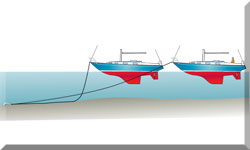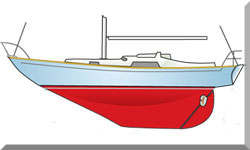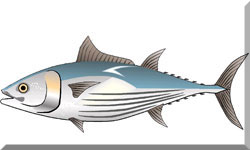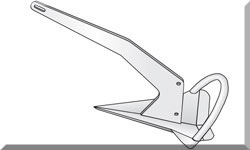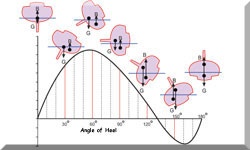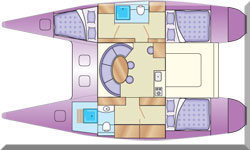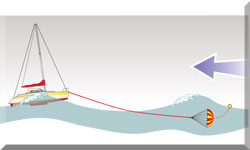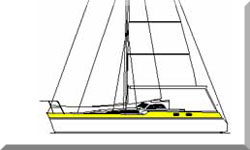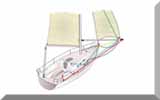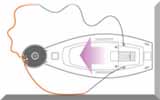- Home
- Cruising Yachts 35' to 40'
- Voyager 35 Sailboat
The Voyager 35 Sailboat
Specs & Key Performance Indicators
The Voyager 35 sailboat, a heavy displacement pilothouse cruising boat, was designed by Angus Primrose and built in the UK by Trident Marine.
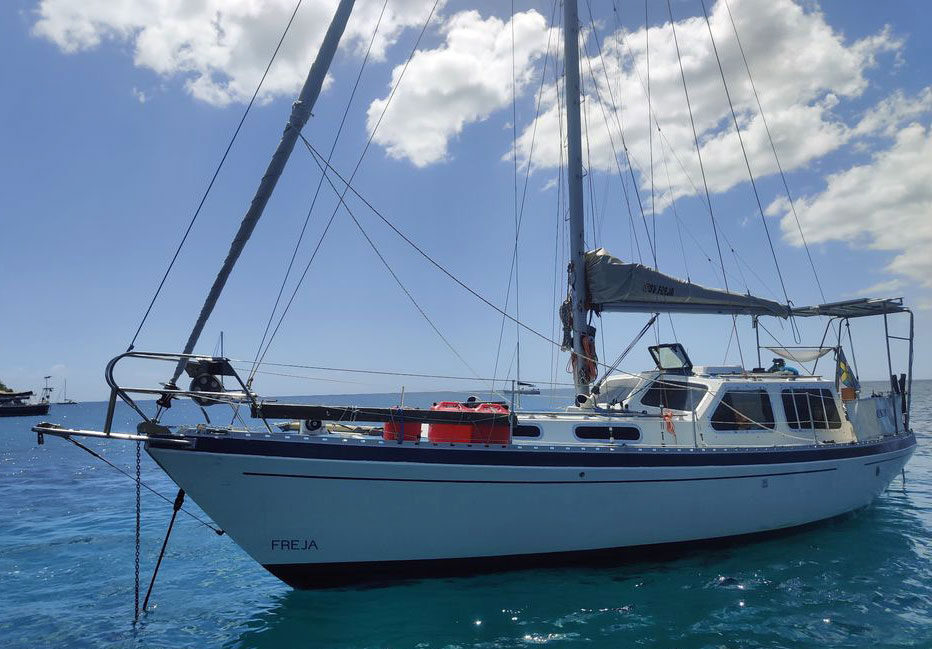 A Trident Voyager 35 pilothouse sailboat at anchor
A Trident Voyager 35 pilothouse sailboat at anchorIn addition to this pilothouse ('Voyager') version, Trident Marine also produced a centre-cockpit ('Warrior') version and an aft-cockpit ('Challenger') version, all of which were based on the Primrose-designed 35-foot hull.
Published Specification for the Voyager 35 Sailboat
Underwater Profile: Long keel
Hull Material: GRP (Fibreglass)
Length Overall: 35'0" (10.7m)
Waterline Length: 26'1" (8.0m)
Beam: 10'6" (3.2m)
Draft: 5'0" (1.5m)
Rig Type: Masthead sloop
Displacement: 14,950lb (6,781kg)
Ballast: 5,100lb (2,313kg)
Designer: Angus Primrose
Builder: Trident Marine (UK)
Year First Built: 1972
Published Design Ratios for the Voyager 35 Sailboat
1. Sail Area/Displacement Ratio: 13.2
2. Ballast/Displacement Ratio: 41.3
3. Displacement/Length Ratio: 314
4. Comfort Ratio: 29.0
5. Capsize Screening Formula: 1.8
Performance Expectations, based on the Design Ratios
The Voyager 35 is a heavy displacement boat, with a displacement/length ratio of 314. This means that it can carry a lot of cruising gear and equipment without affecting its waterline. It also means that it has a stable and predictable motion in a seaway, with a comfort ratio of 29.0. The Voyager 35 is not a fast boat, however, as its sail area/displacement ratio of 13.2 indicates. It will need a good breeze to get going, and it may struggle in light winds. On the other hand, it has a high ballast/displacement ratio of 41.3, which means that it can stand up well to its canvas in a blow and power through the waves. The Voyager 35 sailboat has a long keel and a masthead sloop rig, which makes it easy to handle and balance. It also has a capsize screening formula of 1.8, which suggests that it is a safer choice for ocean passages than boats with higher values.
Production Period and Numbers Produced
The Voyager 35 sailboat was produced by Trident Marine from 1972 to 1986, with about 150 boats built in total. The boat was originally designed by Angus Primrose, a renowned naval architect who also designed many other popular cruising boats, such as the Moody 33 and the Westerly Oceanlord. The Voyager 35 was one of the first pilothouse cruisers in the UK market, offering an enclosed steering station with excellent visibility and protection from the elements.
Alternative Versions & OptionsThe Voyager 35 was one of the three versions based on the same 35-foot hull designed by Angus Primrose. The other two versions were the Warrior (centre-cockpit) and the Challenger (aft-cockpit). The Warrior had a larger aft cabin with an en-suite head, while the Challenger had a more spacious cockpit and a smaller aft cabin. The Voyager had a pilothouse with an inside steering station and a large saloon. All three versions had similar sailing performance and characteristics.
The Voyager 35 had some options available for buyers, such as different engine models (Volvo Penta or Perkins), different keel depths (4'6" or 5'0"), different fuel tank capacities (25 or 40 gallons), different mast heights (43' or 46'), and different interior layouts (two or three cabins).
Number & Location of Sleeping Berths
The Voyager 35 had two or three cabins, depending on the interior layout chosen by the buyer. The standard layout had two cabins: a forward cabin with a V-berth and an aft cabin with a double berth. The alternative layout had three cabins: a forward cabin with two single berths, a midships cabin with two single berths, and an aft cabin with a double berth. Both layouts had a large saloon with a U-shaped dinette that could convert into another double berth. The boat could sleep six to eight people comfortably.
Press Reviews
The Voyager 35 received positive reviews from sailing magazines and experts over the years. Here are some excerpts from some of them:
- "The Trident Voyager is one of those boats that just looks right - solidly built for serious cruising but not too heavy to perform well in light airs." - Yachting Monthly
- "The Trident Voyager is an excellent example of how to design and build an offshore cruising yacht that offers comfort and security without sacrificing performance." - Practical Boat Owner
- "The Trident Voyager is a well-proven bluewater cruiser that can take you anywhere in safety and comfort." - Sailboat Cruising
Owner Testimonials
The Voyager 35 has many loyal and satisfied owners who have shared their experiences and opinions on various forums and websites. Here are some examples of what they have said:
- "We have owned our Voyager 35 for over 20 years and we love her. She is strong, seaworthy, comfortable, and easy to sail. We have cruised extensively in the UK, Europe, and the Caribbean, and she has never let us down." - John & Sue, owners of Voyager 35 'Sea Breeze'
- "We bought our Voyager 35 in 2014 and we have been very happy with her. She is a great boat for living aboard and cruising long distances. She has a spacious and cozy pilothouse that is perfect for all weather conditions. She sails well in all winds and seas, and she handles beautifully." - Mike & Linda, owners of Voyager 35 'Blue Moon'
- "We have had our Voyager 35 for 10 years and we have enjoyed every minute of it. She is a superb boat for offshore sailing and exploring new places. She has a solid and reliable construction, a well-designed and functional interior, and a versatile and balanced rig. She is a pleasure to sail and to live on." - Dave & Anne, owners of Voyager 35 'Wind Song'
History of the Boatbuilder
Trident Marine was founded in 1968 by John Baker, a former director of Westerly Yachts. The company was based in Southampton, England, and specialized in building quality cruising boats designed by Angus Primrose. Trident Marine produced several successful models, such as the Challenger 31, the Warrior 35, the Voyager 35, the Challenger 35, the Warrior 40, the Voyager 40, and the Challenger 40. The company ceased production in 1986 due to financial difficulties.
Secondhand Values
The Voyager 35 is a sought-after boat in the secondhand market, as it offers a lot of value for money. The price range for a used Voyager 35 varies depending on the condition, equipment, and location of the boat, but it generally ranges from £25,000 to £50,000. The average asking price for a Voyager 35 in good condition is around £40,000.
The above text was drafted by sailboat-cruising.com using GPT-4 (OpenAI’s large-scale language-generation model) as a research assistant to develop source material; we believe it to be accurate to the best of our knowledge.
Recent Articles
-
Hans Christian 43: Classic Bluewater Cruiser & Liveaboard Sailboat
Dec 10, 25 04:37 AM
Explore the Hans Christian 43: a legendary heavy-displacement, long-keel sailboat. Read our in-depth review of its specs, design ratios, and suitability for offshore cruising and living aboard. -
Planning Your Sailboat Liveaboard Lifestyle: An Ocean Sailor's Guide
Dec 06, 25 05:18 AM
Seasoned sailors share their methodical risk analysis for planning a secure Sailboat Liveaboard Lifestyle, covering financial, property, and relationship risks. -
Marine Cabin Heaters: The Expert’s Guide to Comfort & Safety at Sea
Dec 05, 25 06:52 AM
Choose the best Marine Cabin Heaters for your vessel. Expert advice on diesel, paraffin, and hot water systems for year-round cruising comfort.

